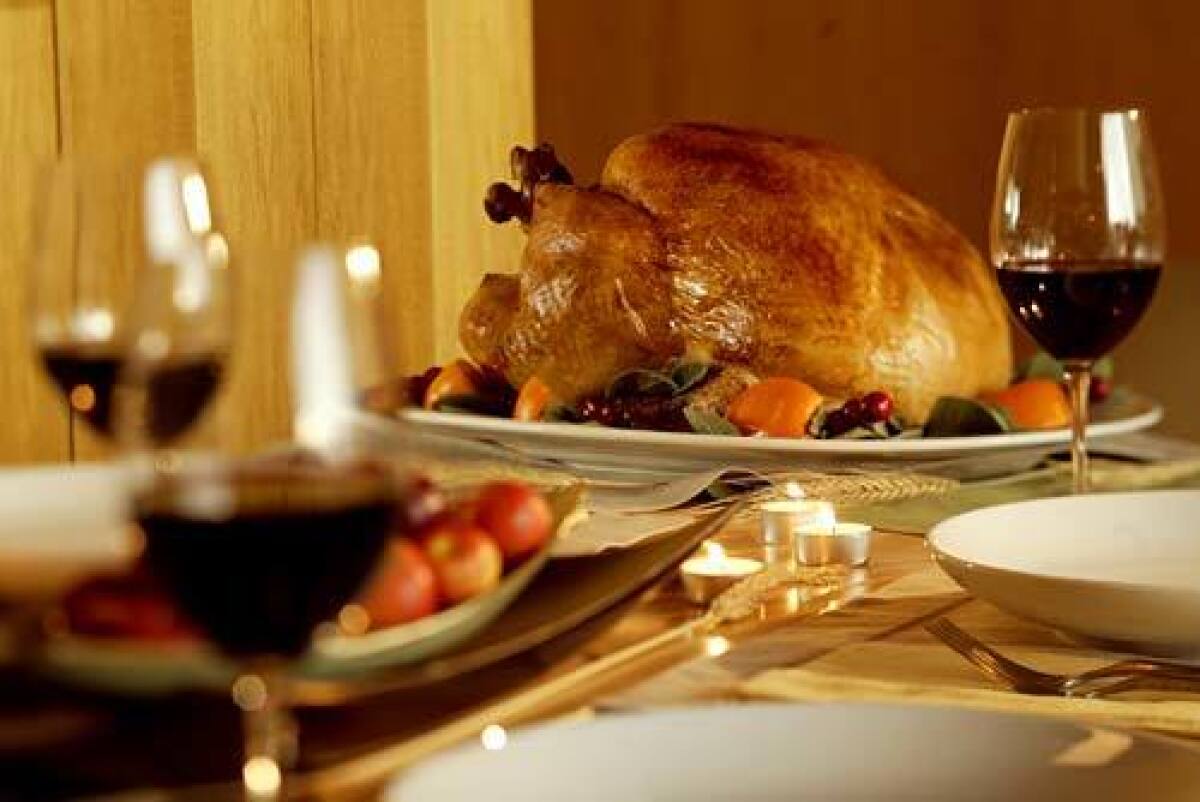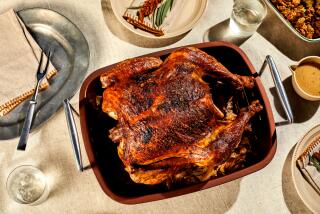Recipe: Brined turkey

- Share via
Total time: 3 hours, plus 2 to 3 days brining time
Servings: 12 plus leftovers
Note: Adapted from Judy Rodgers. You may need more brining liquid depending on the size of your turkey and the bucket used. Increase the amounts of water, salt and sugar proportionately.
2/3 cup salt
1/2 cup sugar
1 gallon cool water
1 (15-pound) turkey, preferably a tom
1 carrot, cut in chunks
1/2 onion, cut in wedges
1 bay leaf
2 to 3 whole black peppercorns
4 tablespoons melted butter
1. Dissolve the salt and the sugar in the water in a bucket large enough to hold the turkey. Rinse the bird well, place it in the brine to cover and let it sit in the refrigerator for 2 or 3 days. If you don’t have room in the refrigerator for a large bucket, place the bird in the brine to cover and leave it at room temperature for 10 to 12 hours. Pour off the brine and place the bird in a pan or on a deep platter, tent it with plastic wrap and refrigerate it for 2 to 3 days, turning it daily and keeping it completely covered in between so it doesn’t dry out.This method produces a less complete cure, but is a good option if space is an issue.
2. The day before you plan to cook, make a stock for the bread salad. Cut away the neck and the tips and middle joints of the wing. Cut the neck into a few pieces and cut the wings in half at the joints. Rinse them and place them in a small saucepan. Add the carrot, onion, bay leaf and peppercorn and add water to cover by 1 1/2 inches. Bring the liquid to a simmer, skim any impurities that float to the top and add a few pinches of salt. Taste; you should barely taste the salt. Adjust the heat to maintain a gentle simmer. Tasting every 15 minutes or so, cook until it tastes like turkey, about 1 1/2 hours. The neck will be nearly falling apart. Strain and refrigerate until needed.
3. To roast the turkey, rinse and pat it dry inside and out and leave it at room temperature for an hour or two. Because it is not completely chilled, it will cook more evenly and rapidly. By arranging for the center to be 10 degrees or so warmer than the refrigerator before you start, you get a juicier result. Heat the oven to 350 degrees. A smaller bird, say a 10-pounder, should be roasted at 375 degrees.
4. Warm a shallow roasting pan on top of a burner (or heat it in the oven). Wipe the turkey back dry one last time and set the turkey in the pan. Because the skin is dry and the pan is hot, this will help prevent sticking later. Brush the surface of the bird with the butter.
5. Place the turkey in the oven and roast until it reaches a temperature of 155 degrees when a thermometer is inserted in the thickest part of the thigh, about 1 1/2 to 2 hours, depending on the size of the turkey, your oven and how cold the turkey was when you placed it in the oven. If the turkey isn’t browning well when the internal temperature reaches about 130 degrees, raise the oven temperature to 400 degrees (or turn on the convection function if you have one). Basting occasionally will help encourage browning, but it is not as efficient as raising the oven to a higher temperature and it doesn’t affect juiciness.
6. When the turkey has reached the desired temperature, remove it from the oven and place it in a warm spot, free of drafts, tightly covered with foil, to finish roasting as it rests for 20 to 30 minutes. Protected as described, the internal temperature will rise about 1 degree a minute for at least 15 minutes, and will continue to rise, although more slowly thereafter. Don’t skip or rush the resting phase, or you risk serving hard, dry, chewy outer bits and moister but still chewy inner sections that may be incompletely cooked.
Each (4-ounce) serving: 264 calories; 32 grams protein; 1 gram carbohydrate; 0 fiber; 14 grams fat; 5 grams saturated fat; 101 mg. cholesterol; 543 mg. sodium.
More to Read
Eat your way across L.A.
Get our weekly Tasting Notes newsletter for reviews, news and more.
You may occasionally receive promotional content from the Los Angeles Times.









